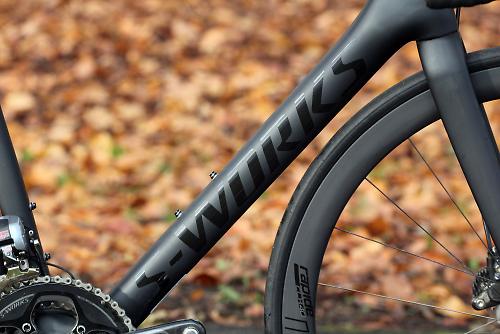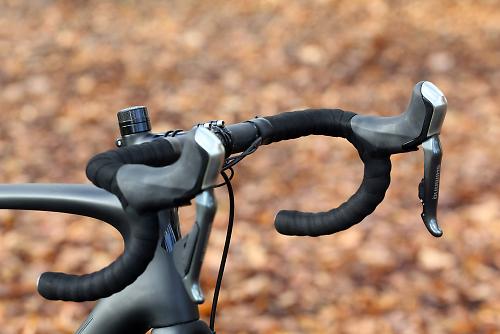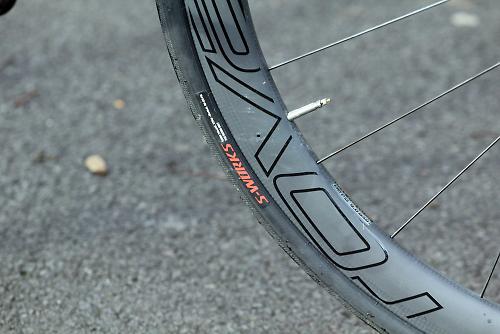- News
- Reviews
- Bikes
- Components
- Bar tape & grips
- Bottom brackets
- Brake & gear cables
- Brake & STI levers
- Brake pads & spares
- Brakes
- Cassettes & freewheels
- Chains
- Chainsets & chainrings
- Derailleurs - front
- Derailleurs - rear
- Forks
- Gear levers & shifters
- Groupsets
- Handlebars & extensions
- Headsets
- Hubs
- Inner tubes
- Pedals
- Quick releases & skewers
- Saddles
- Seatposts
- Stems
- Wheels
- Tyres
- Tubeless valves
- Accessories
- Accessories - misc
- Computer mounts
- Bags
- Bar ends
- Bike bags & cases
- Bottle cages
- Bottles
- Cameras
- Car racks
- Child seats
- Computers
- Glasses
- GPS units
- Helmets
- Lights - front
- Lights - rear
- Lights - sets
- Locks
- Mirrors
- Mudguards
- Racks
- Pumps & CO2 inflators
- Puncture kits
- Reflectives
- Smart watches
- Stands and racks
- Trailers
- Clothing
- Health, fitness and nutrition
- Tools and workshop
- Miscellaneous
- Buyers Guides
- Features
- Forum
- Recommends
- Podcast
TECH NEWS
Just in: Specialized Tarmac S-Works Disc
This stealthy black bike is the 2015 Specialized S-Works Tarmac Disc, the US company’s range-topping race-tuned road bike with Shimano hydraulic disc brakes and Di2 drivetrain, Roval carbon fibre wheels, top-end finishing kit and an eye-watering £8,000 price tag.

Specialized revamped the Tarmac for 2015, not only dispensing with the old naming convention, but also introducing Rider-First Engineered. This essentially means they have developed each frame size independently, instead of simply scaling up or down from the 56cm, which is the usual way. So all tube profiles, shapes and the head tube taper are different across the sizes, meaning a 49cm is very different to a 60cm.

At the same time, Specialized simultaneously developed a disc brake version of the Tarmac. There are very few race-ready bikes with disc brakes, and yes we know you can’t actually race disc-equipped bikes at the moment, but there are still plenty of people that want the performance and geometry of a race bike, with the added benefit of disc brakes.

The disc brakes are very tidily integrated into the frame and fork. The hoses are routed internally at the fork all the way through the down tube to the chainstay, where the hose pops out just in front of the brake caliper. The Di2 wiring is internally routed too. The new integrated seatclamp cleans up the top tube nicely and also provides more seatpost extension, allowing the 27.2mm to deflect a little more, providing a bit more impact absorption.

Specialized offer three disc-equipped models for 2015, with the range starting with the Tarmac Pro Disc Race at £4,500, and above it the Tarmac Pro Disc Race Di2 at £5,500. They don’t really expect to sell many of £8,000, it’s more a showcase for what is possible if money is no object, but that said we’re sure they’ll sell enough to make it worthwhile. As a case study of what is possible, it’s certainly impressive, and you could consider this a glimpse at what all race bikes might look like one. Controversial I know...

It’s no surprise it’s the lightest disc-equipped road bike we’ve ever had through the office, hitting 6.9kg on the road.cc Scales of Truth. That’s because there is really no weight increase on the disc version of the Tarmac frame, and because it’s laden with top-end kit. That kit includes a Shimano Dura-Ace Di2 groupset and RS785 hydraulic disc brakes, with 140mm rotors at both ends.

The only deviation from the Shimano catalogue is the S-Works carbon fibre crankset, a sleek looking unit with Shimano chainrings bolted to it.

The wheels are Roval Rapide CLX 40 SCS Disc, with CeramicSpeed bearings, and fitted with S-Works Turbo tyres in a 24mm width. There are regular quick release axles as well, Specialized choosing to stay away from thru-axles while there is no clear standard or agreement on the future of axle choices on disc-equipped road bikes.

The rest of the kit is similarly top shelf stuff. A Body Geometry Toupe Pro saddle with carbon fibre rails atop an S-Works FACT carbon 27.2mm seatpost with a 20mm offset clamp. S-Works SL Carbon shallow drop (125mm drop, 75mm reach) handlebars, S-Works SL aluminium stem and Specialized Classic gel tape completes the build.

The Tarmac Disc shares exactly the same geometry as the non-disc Tarmac, but to get around the issue of the 405mm chainstays causing chainline issues, which would ultimately be detrimental to the drivetrain performance in certain gears, Specialized have designed a hub that places the cassette 5mm further inboard. Shimano advise a minimum 415mm chainstay length when using disc brakes, so you can see the problem with fitting disc brakes on race bikes, it’s not just a case of slapping on a disc mount and changing the wheel.

A regular road bike has a 130mm rear axle, but disc bikes have 135mm spacing. Specialized’s rather neat arrangement effectively places the cassette where it would be if it were a 130mm rear hub, and uses a new derailleur hanger and dropout that places the derailleur 2.5mm further inboard. This keeps the chain line sweet but does mean you can't easily change wheels without potentially fouling the chain line. It's the only solution we’ve yet seen for keeping the short chainstays of a race bike while widening out the axle to 135mm to accommodate the disc brake.

We’ve tested a number of disc-equipped road bikes this year, but all of them have been endurance bikes, those aimed at providing comfort on longer rides. This Tarmac is the first actual race bike with disc brakes we’ve yet seen, it’s a rare breed that much is true, and provides an interesting glimpse at what race bikes might look like one day, if the UCI do ratify disc brakes for racing. All that remains it to hit the road, get the miles in, and report back soon with our findings.
David worked on the road.cc tech team from 2012-2020. Previously he was editor of Bikemagic.com and before that staff writer at RCUK. He's a seasoned cyclist of all disciplines, from road to mountain biking, touring to cyclo-cross, he only wishes he had time to ride them all. He's mildly competitive, though he'll never admit it, and is a frequent road racer but is too lazy to do really well. He currently resides in the Cotswolds, and you can now find him over on his own YouTube channel David Arthur - Just Ride Bikes.
Latest Comments
- AidanR 9 min 58 sec ago
Bloody hell... How are you doing now?
- ktache 18 min 21 sec ago
And I liked endura too. Got a nice long sleeve mostly merino long sleeve a little while back, in orange.
- matthewn5 46 min 24 sec ago
No, the Ebay lights have been around for several years, this Lezyne light just appeared.
- chrisonabike 1 hour 2 min ago
They shouldn't worry - the second part of the "tariff" refrain is "they can make it in US and they'll do very well".
- Mr Blackbird 1 hour 34 min ago
"At the going down of the sun, it will get in our eyes and cause us to crash into things."
- Rendel Harris 1 hour 42 min ago
Been living in the area thirty years now and Brixton Cycles (and local riders wearing their famed Rastafarian colours jersey) has been an iconic...
- chrisonabike 3 hours 47 min ago
Does the "super-loud yellow" also help alert (non-deaf / non-earbud-wearing) pedestrians? Or will it just mean dogs bark at me?
- Festus 4 hours 38 min ago
One thing that bothers me is the use of antidepressant med and driving, it never gets picked up by police. Most of these types of medicines state...
- chrisonabike 6 hours 38 min ago
Indeed - but again these are perhaps questions we should keep asking. Even if the immediate answer is "well we are where we are" or "how on earth...

































Add new comment
11 comments
Is there a good reason why the UCI don't allow racing on disc equipped bikes? Cross & mtb can, which is UCI...what's the deal with road racing?
It's a safety issue. The pro's tend to be much faster than your average joe, so being able to brake more safely on descents etc, would be er, more safe, so...sorry lost my trail of thought
Meanwhile in other news they found water on a comet that they landed a craft on, in space...but by the time they are UCI approved, maybe man will be on Mars!
I thought that - maybe disc brakes can't provide the stopping power for pro's flying down the Alps. But have you seen the speeds these downhillers descend at? And they're not lightweight road riders on lightweight bikes, so the force their brakes needs must be pretty high. And it isn't really "safety", the UCI have shown that rider safety comes a distant 2nd in their considerations. "Stelvio, in the snow? Ah, you'll be fine, off you go.....".
First disc bike that's made me drool. A bit.
Saw one of these in the workshop at Specialized Concept Store Covent Garden on Tuesday, strangely with no rotors as they were not supplied with the bike but on the way from the supplier
Very good looking bike. Always loved Tarmac's (I have a USA colour SL4 Elite) and this latest version just continues my passion for the Tarmac line.
Although locked into using the proprietary Roval wheelset, you get solid warranty and servicing backup for Roval from Specialized UK service centre in Chessington, which in my experience as a mechanic makes "ownership" of factory wheels a lot less painful, compared to some brands we've tried to get support from, for our customers
A bit of the maths is out somewhere there. The 135mm hub puts the cassette 2.5 mm further out (the hub is 2.5mm wider on each side). So if Specialized have moved the cassette 5mm in, then it's 2.5mm further in than a normal road wheel, which isn't going to be good for the dish. Surely they moved it back in 2.5mm?
Yes, the hub places the cassette where it would be if it were a 130mm rear hub, and uses a new derailleur hanger and dropout that places the derailleur 2.5mm further inboard.
Another grey / black bike. Can't be long before the pendulum swings back to the truly beautiful & colourful paint jobs of yesteryear!
Where on earth is CJSTEVENS1955 when you need him?
Very very nice come on lotto
Hmmm, seen this paint job before... Colnago CX Zero Evo